Done for 2009: The Holiday MacBook Pro Roundup
by Anand Lal Shimpi on November 10, 2009 12:00 AM EST- Posted in
- Mac
Performance
Benchmarking under OS X is a bit of a pain. There aren't many good standardized real world benchmarks, and unfortunately the synthetic tests are often over used.
General OS usage is a difficult thing to quantify, but one measure of performance has always been the number of bounces an icon in the dock makes before an application loads. I decided to take it to the next level and write a quick script to launch 15 applications in a row, timing how long the entire process takes.
I launched, in order: Mail, Safari, Activity Monitor, iTunes, iCal, DVD Player, iPhoto, Photo Booth, Quicktime Player, Disk Utility, Preview, iMovie, Front Row, Garage Band and Aperture.
The entire process stresses both the disk and CPU, which is why we see a huge improvement when going to an SSD as well as differences between CPU speeds.
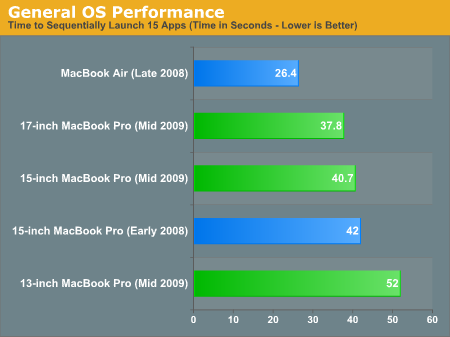
The 13-inch MacBook Pro performs the worst here by a large margin, not just because of its lowly 2.26GHz Core 2 Duo, but also because it only has 2GB of memory. The 13-inch system takes nearly 30% longer to load all of the apps because of its limited amount of memory.
The 15-inch MacBook Pro uses a 2.53GHz Core 2 Duo instead of the 2.80GHz chip in the 17-inch by default. The result is a 7% longer load time on the 15-inch system, not huge, but not insignificant. As always, I recommend getting the fastest CPU you can afford if you're planning on keeping this machine for a while.
The fastest machine here is actually the MacBook Air, because it comes with an SSD. Your best bet to improve overall system responsiveness and launch times is to get a good SSD. Even with only 2GB of memory, the current gen MacBook Air finishes the script faster than the 17-inch MacBook Pro. Paired with an Intel X25-M G2 the 15-inch MacBook Pro can run through our script in 16 seconds.
Adobe Photoshop CS4 Performance
The Retouch Artists Speed Test we use for our CPU testing under Windows also works under OS X. We're running the exact same benchmark here, basically performing a bunch of image manipulations and filters and timing the entire process.
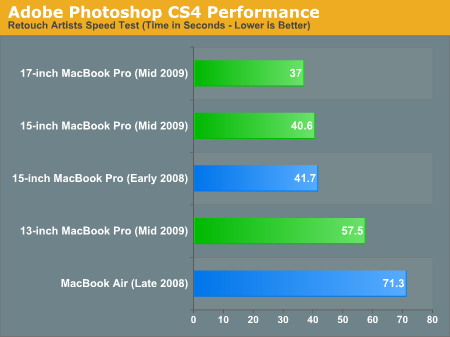
Despite limiting Photoshop to not keeping any history, the 2GB 13-inch MacBook Pro takes around 40% longer to complete the test than the 15-inch MacBook Pro. If you're planning on doing any Photoshop work you'll want to upgrade the 13-inch system to 4GB of memory.
The slower CPU in the 15-inch system penalizes it by around 10% compared to the 17-inch MacBook Pro. For any sort of real performance work, it looks like a 15-inch MacBook Pro with the 2.80GHz upgrade would be a good balance of price/performance.
As I alluded to earlier, there's not much of a performance improvement from the early 2008 MacBook Pro to the current generation. Drive speeds have improved a bit but overall performance hasn't really gone up, it's why Apple had to rely on updated looks and much better battery life to sell systems this time around. Not a bad tradeoff if you ask me, you'll see the performance improvement next year with Arrandale.
Aperture 2 RAW Import
For my Aperture test I simply timed how long it took to import 203 12MP RAW images into the library.
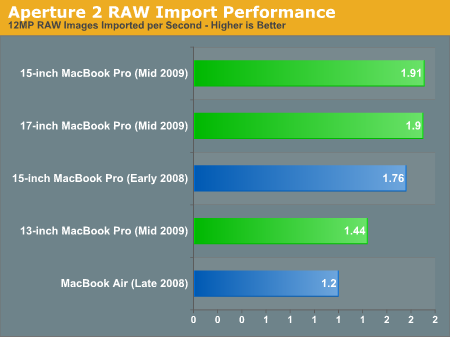
Once again, 2GB isn't enough, the 15-inch and 17-inch are indistinguishable but the 13-inch system takes much longer here.
Cinebench R10
3D rendering performance is mostly CPU bound so the 13-inch system isn't penalized by its memory limitations. Here the 2.53GHz Core 2 Duo is around 11% faster than the 2.26GHz in the 13-inch MBP. The 2.80GHz CPU is another 11% faster on top of that.
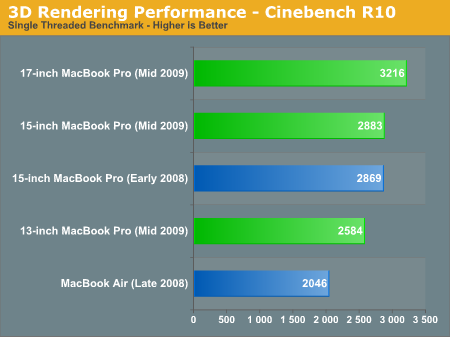
In the multithreaded bench the performance advantages are about the same, a bit closer to 12% between chips.
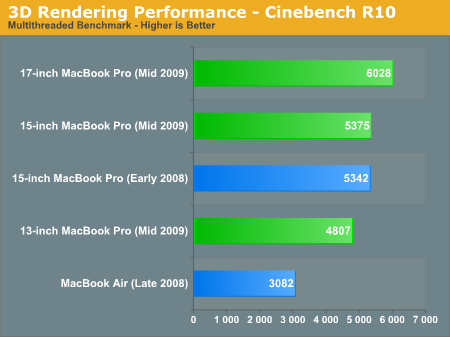
Again we see that CPU speed hasn't really improved much since early 2008, the two 15-inch systems are basically equal performers here.
Quicktime H.264 Video Encoding
Our final benchmark is more consumer focused. Here I'm taking an XviD and converting it to an iPhone-supported H.264 format.
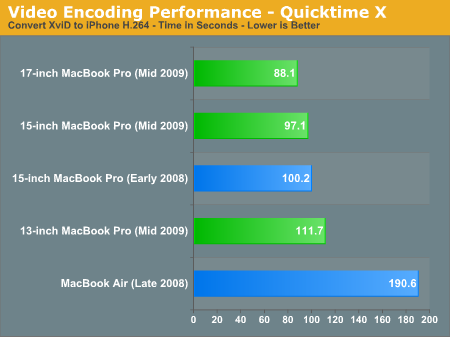
We're CPU bound here so the 13-inch system only takes 14% longer to convert our video clip than the 15-inch. The difference between the 15-inch and 17-inch is about another 10%.










115 Comments
View All Comments
DigitalFreak - Wednesday, November 11, 2009 - link
LOL. Not to mention all their products that have caught fire, melted, discolored, overheated... I could go on and on. QC is definitely NOT one of Apple's strong points.sprockkets - Wednesday, November 11, 2009 - link
When any other laptop discolors, it's business as usual.When it happens to an Apple product, the users raise hell, and Apple replaces it for free even if it is no longer under warranty.
There's your explanation.
damianrobertjones - Wednesday, November 11, 2009 - link
Tell that to many, many people that have dead ipods/iphones/macs. Just read some forums and you'll find that apple often turn people away EVEN when in warrantyJimmyJimmington - Wednesday, November 11, 2009 - link
My dead iPod was turned away at an Apple store even though it was under warranty. Took one look at it and said no way. I shipped it to them using some online form and they replaced it no questions asked :/solipsism - Tuesday, November 10, 2009 - link
[quote]Even Apple's default hardware choices make a lot of sense. You pay more for faster processors and larger screens. My biggest complaint, as always, is that Apple doesn't give the entry level 13-inch MacBook Pro enough memory.[/quote]— For their cheapest machine it’s more than adequate for the average consumer. This shows that without having a single piece of crapware installed the memory footprint of a new system is quite low compared to other vendors.
• [url]http://www.pcpro.co.uk/features/352903/apple-the-c...[/url]
fyleow - Tuesday, November 10, 2009 - link
I'm a bit surprised on the lack of comment regarding screen resolution. The 15 inch MBP is a particularly bad offender with only 1440 x 900. That's unacceptable when competitors have been offering much higher resolution for awhile now.Hopefully the next generation will bring higher screen resolutions. The only acceptable resolution in the line up is the 17 inch and maybe the 13 inch though some manufacturers are offering 1600 x 900 screens.
solipsism - Wednesday, November 11, 2009 - link
One area that Apple just doesn’t do well is scaling of visual elements. Until they can offer something like Windows Presentation Foundation or actually get RI then they really can’t move to a higher dot pitch. The 17” ppi to high for me.The area that I’m surprised I didn’t see mentioned is the display type and backlight used on all MBPs. These are uneven, low-luminous LCD backlights and cheap TN displays. I don’t know if the non-Macs in the article are using similar tech, better, for the comparison, but most notebooks on the market use cheap displays. I find this to be as important than having a slightly faster CPU.
solipsism - Wednesday, November 11, 2009 - link
Oops, meant to write… "These aren’t…"londor - Wednesday, November 11, 2009 - link
Current MBPs have high quality displays.http://www.robgalbraith.com/bins/multi_page.asp?ci...">http://www.robgalbraith.com/bins/multi_page.asp?ci...
Zak - Wednesday, November 11, 2009 - link
Um? Not sure what you're talking about. They're very bright LED back-lit screens.Z.